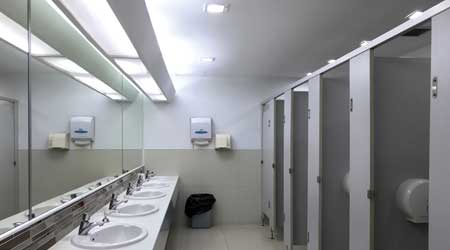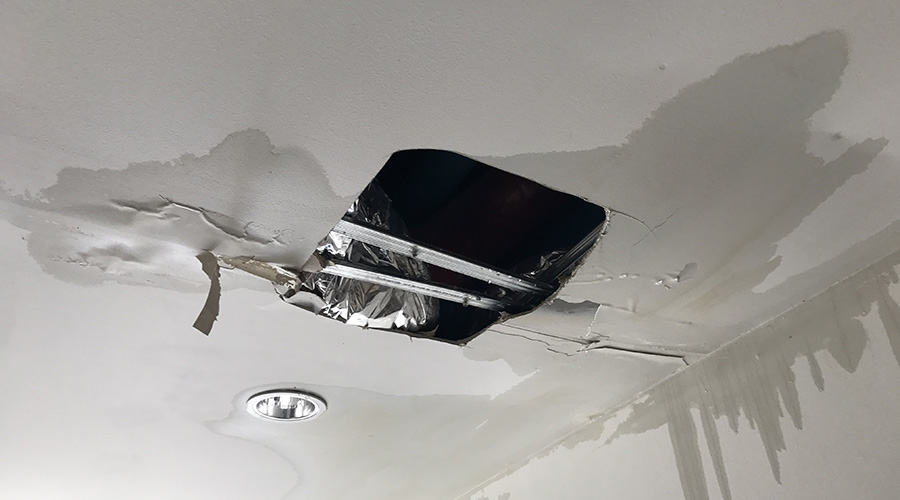 As concern over COVID-19 continues, managers can expect more probing questions from occupants leery about infection prevention measures in restrooms.
As concern over COVID-19 continues, managers can expect more probing questions from occupants leery about infection prevention measures in restrooms.Planning Restroom Upgrades in the COVID-19 Era
Here's how to rethink products and projects to meet evolving user expectations.
Restrooms and plumbing systems have rarely been under as much scrutiny as they are right now. Beyond long-standing organizational goals related to water conservation and user comfort, maintenance and engineering managers now must incorporate occupant health concerns related to the threat of COVID-19 transmission into plans to upgrade restrooms and plumbing systems.
For manufacturers of plumbing and restroom products, the renewed focus on restrooms means, in part, that they are fielding more questions from managers in the process of specifying products and planning upgrades.
“There has never been a greater focus on overall facility hygiene,” says Scott Hager with Ferguson Enterprises. “As a distributor with a national scope, we see a lot of activity around retrofitting conventional washrooms to touchless. This includes touchless flush valves, faucets, skincare and towel dispensers. Additionally, many facilities managers are installing foot or arm door hardware for a completely hands-free experience.”
The volume of traffic moving through these areas compounds the complexity of the challenges facing managers.
“As one of the most visited spaces in any commercial building, restrooms can be a breeding ground for germs and bacteria,” says Mark Lawinger with Sloan Valve Co. “When people enter a public restroom now, the last thing they want to do is touch a surface such as manual faucet or flushometer handles.”
Expectations and demands
Whatever building occupants and visitors once expected of restrooms, everything is different in the COVID-19 era.
“The spread of COVID has accelerated widespread demand for touchless restroom fixtures, making the use of levers, handles and buttons somewhat outdated,” says Will Haas with Bradley Corp. “This old technology is especially being shunned by end users who are averse to touching any surfaces — faucets, soap dispensers, hand dryers, handles, doors, toilet flushers, etc. — in restrooms.”
The specific challenges of non-residential restrooms can be of particular concern to users.
“There is more concern about the spread of germs and viruses through fixtures in the restroom, especially in commercial applications where toilets do not have a seat cover,” says Matt Voorhees of Niagara Corp. “Touchless, sensored fixtures are already immensely popular, but building managers are now considering fixtures made with antimicrobial materials, as well.”
As concern about COVID-19 continues among the general public, managers can expect to field more probing questions from occupants about infection prevention measures in restrooms.
“There’s a growing shift for using natural and sustainable materials that are easy to clean and disinfect while being smooth and non-porous with seamless construction, helping to prevent bacteria, mold, mildew, and delamination accumulation,” Haas says. “These types of cast-formed materials are very easy to clean, maintain, repair and renew.”
Planning issues
With these expectations and concerns about restrooms and plumbing systems in mind, managers can begin to lay out projects to improve restroom hygiene. One early issue to determine is whether the project under discussion is a retrofit or an upgrade.
“Commercial restroom retrofits are actually the easy part of the process to upgrade fixtures from manual to touch-free, as many sensor-operated fixtures can be installed in just a matter of minutes,” Lawinger says. “The challenging part when upgrading a restroom, or specifically re-opening your facility after several months, is managing the risks that are associated with prolonged system inactivity.
“Water that sits in plumbing lines for extended periods of time becomes stagnant, which could lead to elevated levels of lead and copper. This water also has the potential to contain little to no residual disinfectant, leading to elevated levels of bacteria and other microbiological contaminants.”
Low occupancy in buildings makes it easier for contractors and in-house maintenance staff to access areas being upgraded.
“It is a great time to plan an upgrade,” Hager says. “In most major metropolitan markets, many people continue to work remotely, and office space remains empty, making upgrades less disruptive to the workday. At the same time, there is an enormous demand in our industry that can stretch lead times and put strains on the supply chain.”
Also working against managers planning upgrades is the most obvious issue — the threat of COVID-19 infection.
“In general, scheduling has been more difficult due to COVID-related restrictions and shutdowns, especially in hard-hit areas,” Haas says. “Keep in mind that restrooms are often smaller with tight spaces, so it’s critical to schedule enough time in between contractors to help with social distancing and ventilation.”
Managers weighing the timing of restroom or plumbing system upgrades in the near future also might be wise to consider the impact the pandemic will have on the demand for products and contractor services.
“Labor shortages, shipping, trucking and manufacturing limitations are present due to the pandemic, causing product delivery and availability to be delayed, depending on the manufacturer,” Vorhees says. “Many building managers are concerned that once the pandemic fades, manufacturers won’t be able to keep up with the demand to produce products when they need to order it for renovations.
“We’re seeing indications that once the pandemic goes away, there will be a high demand for building renovations. As a result, we’re working to help architects, builders, and building engineers plan for renovations for when this construction begins and are finding demand for ideas on toilets that conserve water and require less maintenance.”
Related Topics:













